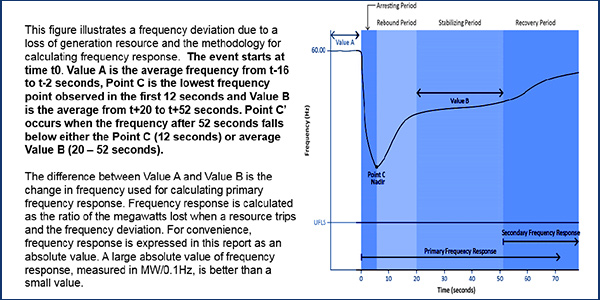By Rich Heidorn Jr.
ATLANTA — Despite the ongoing shift to renewables, the Eastern Interconnection has sufficient inertia to maintain system frequency for at least the next five years, according to a study released Thursday.
The Eastern Interconnection Planning Collaborative (EIPC), a group of 20 planning coordinators, conducted the study in response to a request by NERC’s Essential Reliability Services Working Group.
The working group had cited concerns about the retirements of synchronous generators such as coal and nuclear, which respond automatically to a frequency reduction by slowing down and releasing more energy into the grid. Asynchronous wind and solar power generators do not respond in the same way unless their inverters have been programmed to provide frequency control.
The EIPC’s study was released as a NERC standards development team (SDT) reviewing other aspects of frequency response issued a request for comment on continuing to rely on FERC Form 714 for data. (See “Comments Sought” below.)
Steven Judd, lead engineer in system planning for ISO-NE and chair of the EIPC Frequency Response Task Force, said the study provided reassurance in the near term and a foundation for future projects.
“This first effort to track the interconnection’s inertial response has established a framework and baseline for system planners to improve the system network models going forward, provide sufficient notice when the changing resource mix could have an adverse effect on frequency response and develop solutions to those adverse effects,” Judd said.
In order to prepare for the expected increase in nonsynchronous generation with reduced inertia, the report said planners will need improved frequency responsive power flow simulation models.
The report was based on several analyses, including benchmarking a historical frequency event with spring light load (SLL) cases, and concluded that about 45% of governors were providing primary frequency response, substantially higher than previous NERC studies, which pegged response at about 30%. Thus, for forward-looking frequency measures, 55% of the governors were disabled in the power flow model.
“It is expected future improvements to the modeling of governors through new compliance standards and updated simulation models from the software vendors will reduce the need for artificially disabling governor models to match historical performance,” the task force said.
FERC Order 842, issued in February 2018, requires all new generators seeking interconnections be equipped to provide primary frequency response. (See FERC Finalizes Frequency Response Requirement.)
The EIPC task force tested three frequency events against the 2022 SLL Multiregional Modeling Working Group (MMWG) power flow case:
- The loss of 4,500 MW of generation in 2007, the largest historical event seen on the EI;
- The loss of 3,100 MW on April 27, 2011, the largest event within the past 10 years; and
- The loss of 2,513.7 MW, the most severe single contingency for the EI as defined by NERC standard BAL-002-2(i) Requirement R2.2.
In all three events, frequency response fell no lower than 59.85 Hz, well above the 59.5-Hz initial set point that would trigger under frequency load shedding (UFLS).
Under a fourth benchmark — a 10,000-MW loss modeled to determine the margin available in the EI — the frequency dropped to a low of 59.64 Hz, still above the UFLS set point.
“In other words, the system inertia and primary frequency response will be sufficient even with expected retirements of synchronous generation and increases in nonsynchronous generation,” the report said.
The results of the analysis were submitted to NERC for inclusion in its 2018 long-term reliability assessment.
Comments Sought

On a related issue, the SDT for Project 2017-01 (Modifications to BAL-003-1.1) on Thursday issued a request for comments following a three-day meeting last week in Atlanta.
Phase II of the project is considering potential changes to make the interconnection frequency response obligation (IFRO) calculations and associated allocations more reflective of current conditions, considering load response and the generation mix.
The standard authorization request also requires the team to ensure that overperformance by one entity does not negatively impact the evaluation of performance by another and that measurements of primary frequency response are considered in addition to secondary frequency response.
“I think we’ve got a fairly balanced industry [view]” on the standard, said SDT Chair David Lemmons, of EthosEnergy. “Some people think things need to change. Some people are happy with where it is.”
The SDT asked commenters to address the fact that load and generation data from Form 714 is two years old by the time it is applied to actual operations under the standard. In the interim, balancing authority (BA) footprints can change.
Rich Hydzik of Avista said Form 714 was adequate for use under the standard and expressed concern that more current data might be “less robust.”
“I don’t think we want perfection to be the enemy of good here,” he said. “What we’re looking for is a fair allocation on the interconnection and the BAs.”
Greg Park of Northwest Power Pool and SPP’s Daniel Baker noted Form 714 also does not include data from Mexico or Canada.
“I think [714] does an adequate job … 99% adequate,” Park said. “But that 1% is administratively burdensome.”
Hydzik suggested later the data source could be dictated by the “fundamental question” of whether it is generators alone that are responsible for meeting the frequency response requirement (FRR). He noted load reductions don’t provide much frequency response “unless generally you’re paying for load to drop.”
Including load strengthens the case for retaining Form 714, which includes load and generation data, he said.
“If you’re going to make the leap that energy-producing resources actually provide your FRR … then we kind of move into the situation where we look at generation-only numbers and … allocate that way. It starts to look a little bit like [Texas Reliability Entity] at that point. … They have shown us what it looks like to go with the generation approach.”






